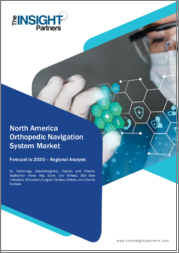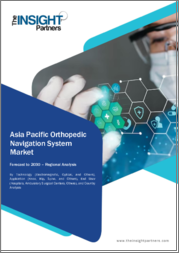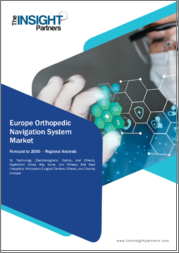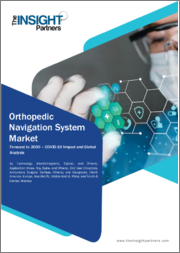
|
시장보고서
상품코드
1595103
정형외과용 내비게이션 시스템 시장 : 기술, 용도, 최종 용도별 - 세계 예측(2025-2030년)Orthopedic Navigation Systems Market by Technology (Electromagnetic, Fluoroscopy, MRI), Application (Hip, Knee, Replacement Surgeries), End-use - Global Forecast 2025-2030 |
||||||
정형외과용 내비게이션 시스템 시장은 2023년에 30억 1,000만 달러로 평가되었습니다. 2024년에는 34억 8,000만 달러에 이를 것으로 예측되며, CAGR 15.58%로 성장하여 2030년에는 83억 달러에 달할 전망입니다.
정형외과용 내비게이션 시스템은 정형외과 수술 시 외과 의사를 지원하는 데 사용되는 첨단 도구로, 실시간으로 공간 데이터를 제공하여 정확도와 치료 결과를 향상시킵니다. 이러한 시스템의 필요성은 정형외과 수술의 복잡성 증가, 최소 침습 수술에 대한 수요 증가, 수술 결과 개선에 대한 강조로 인해 강조되고 있습니다. 이러한 시스템은 인공관절 치환술, 척추 수술, 골절 고정술 등 다양한 정형외과 수술에 적용되고 있으며, 최종 사용처는 병원, 외래수술센터(ASC), 정형외과 전문 클리닉에 이르기까지 다양합니다. 이러한 시스템 시장은 의료 기술의 발전, 정형외과 질환의 유병률 증가, 인구 고령화 등의 요인에 영향을 받고 있습니다. 주요 성장 기회는 인공지능과 머신러닝을 통합하여 시스템 기능을 향상시키고, 외과 의사가 보다 쉽게 사용할 수 있는 인터페이스를 강화하며, 의료 인프라가 빠르게 발전하고 있는 신흥 시장으로의 진출에 있으며, 특히 3D 내비게이션 기술과 로봇 공학의 통합에 대한 혁신은 매우 유망합니다. 이러한 기회에도 불구하고, 높은 설치 및 운영 비용, 엄격한 규제 요건, 첨단 시스템을 다룰 수 있는 숙련된 인력의 필요성 등이 제약 요인으로 작용하고 있습니다. 또한, 코로나19는 의료 시설에 재정적 부담을 가중시켜 선택적 수술과 신기술에 대한 투자를 지연시키고 있습니다. 기술 혁신의 여지는 비용 절감 전략, 정형외과 직원 교육 프로그램, 새로운 디지털 헬스 트렌드에 대응하는 시스템 개발에 있습니다. 무선 시스템 및 영상 기술 개선에 대한 연구도 잠재력을 가지고 있습니다. 이 시장은 제품 차별화를 위해 연구개발에 많은 투자를 하고 있는 주요 업체들 간의 경쟁으로 특징지어집니다. 각 기업은 전략적 파트너십, 고객 교육, 시장별 맞춤화에 집중하여 보급을 촉진해야 합니다. 비용 및 규제 환경의 장애물을 해결하고, 임상 지원을 확대하며, 기술 발전을 활용함으로써 이해관계자들은 진화하는 환경에서 성장을 위한 더 나은 입지를 확보할 수 있습니다.
| 주요 시장 통계 | |
|---|---|
| 기준 연도(2023년) | 30억 1,000만 달러 |
| 예측 연도(2024년) | 34억 8,000만 달러 |
| 예측 연도(2030년) | 83억 달러 |
| CAGR(%) | 15.58% |
시장 역학: 빠르게 진화하는 정형외과용 내비게이션 시스템 시장의 주요 시장 인사이트 공개
정형외과용 내비게이션 시스템 시장은 수요 및 공급의 역동적인 상호작용에 의해 변화하고 있습니다. 이러한 시장 역학의 진화를 이해함으로써 기업은 정보에 입각한 투자 결정, 전략적 의사결정, 새로운 비즈니스 기회를 포착할 수 있습니다. 이러한 트렌드를 종합적으로 파악함으로써 기업은 정치적, 지리적, 기술적, 사회적, 경제적 영역에 걸친 다양한 리스크를 완화하고, 소비자 행동과 그것이 제조 비용 및 구매 동향에 미치는 영향을 보다 명확하게 이해할 수 있습니다.
- 시장 성장 촉진요인
- 전 세계 정형외과 질환 증가에 따른 잠재적 수요 증가
- 정형외과 수술과 관련된 전 세계 노인 인구 증가
- 3D 시각화와 함께 컴퓨터 지원 기술을 이용한 발전이 가속화되고 있습니다.
- 시장 성장 억제요인
- 정형외과 내비게이션 시스템 도입에 따른 고비용
- 시장 기회
- 내비게이션의 정밀도와 정확성 관련 발전 증가
- 정형외과 시스템의 유리한 성장을 위한 지속적인 정부 자금 지원
- 시장 과제
- 보건의료 분야의 숙련된 전문 인력 부족
Portre's Five Forces: 정형외과용 내비게이션 시스템 시장 공략을 위한 전략적 도구
Portre's Five Forces 프레임워크는 시장 상황경쟁 구도를 이해하는 중요한 도구입니다. Portre's Five Forces 프레임워크는 기업의 경쟁력을 평가하고 전략적 기회를 탐색할 수 있는 명확한 방법을 제공합니다. 이 프레임워크는 기업이 시장 내 세력도를 평가하고 신규 사업의 수익성을 판단하는 데 도움이 됩니다. 이러한 통찰력을 통해 기업은 강점을 활용하고, 약점을 해결하고, 잠재적인 도전을 피하고, 보다 강력한 시장 포지셔닝을 확보할 수 있습니다.
PESTLE 분석 : 정형외과용 내비게이션 시장의 외부 영향력 파악
외부 거시 환경 요인은 정형외과용 내비게이션 시스템 시장의 성과 역학을 형성하는 데 매우 중요한 역할을 합니다. 정치적, 경제적, 사회적, 기술적, 법적, 환경적 요인에 대한 분석은 이러한 영향을 탐색하는 데 필요한 정보를 제공하며, PESTLE 요인을 조사함으로써 기업은 잠재적 위험과 기회를 더 잘 이해할 수 있습니다. 이러한 분석을 통해 기업은 규제, 소비자 선호도, 경제 동향의 변화를 예측하고 선제적이고 능동적인 의사결정을 내릴 준비를 할 수 있습니다.
시장 점유율 분석 정형외과용 내비게이션 시장 경쟁 구도 파악
정형외과용 내비게이션 시스템 시장의 상세한 시장 점유율 분석을 통해 공급업체의 성과를 종합적으로 평가할 수 있습니다. 기업은 수익, 고객 기반, 성장률과 같은 주요 지표를 비교하여 경쟁적 위치를 파악할 수 있습니다. 이 분석은 시장의 집중화, 단편화, 통합의 추세를 파악할 수 있으며, 공급업체는 치열한 경쟁 속에서 자신의 입지를 강화할 수 있는 전략적 의사결정을 내리는 데 필요한 통찰력을 얻을 수 있습니다.
FPNV 포지셔닝 매트릭스 정형외과용 네비게이션 시스템 시장에서의 벤더 성과 평가
FPNV 포지셔닝 매트릭스는 정형외과용 내비게이션 시스템 시장에서 벤더를 평가하는 중요한 도구입니다. 이 매트릭스를 통해 비즈니스 조직은 벤더의 비즈니스 전략과 제품 만족도를 기반으로 평가하여 목표에 부합하는 정보에 입각한 의사결정을 내릴 수 있으며, 4개의 사분면으로 벤더를 명확하고 정확하게 세분화하여 전략 목표에 가장 적합한 파트너와 솔루션을 식별할 수 있습니다. 전략 목표에 가장 적합한 파트너와 솔루션을 식별할 수 있습니다.
전략 분석 및 추천 정형외과용 내비게이션 시장에서 성공의 길을 그리다.
정형외과용 내비게이션 시스템 시장 전략 분석은 세계 시장에서 입지를 강화하고자 하는 기업에게 필수적입니다. 주요 자원, 역량 및 성과 지표를 검토함으로써 기업은 성장 기회를 식별하고 개선할 수 있습니다. 이러한 접근 방식을 통해 경쟁 환경의 도전을 극복하고 새로운 비즈니스 기회를 활용하여 장기적인 성공을 거둘 수 있도록 준비할 수 있습니다.
이 보고서는 주요 관심 분야를 포괄하는 시장에 대한 종합적인 분석을 제공합니다.
1. 시장 침투도 : 현재 시장 환경의 상세한 검토, 주요 기업의 광범위한 데이터, 시장 도달 범위 및 전반적인 영향력 평가.
2. 시장 개척도: 신흥 시장에서의 성장 기회를 파악하고, 기존 분야의 확장 가능성을 평가하며, 미래 성장을 위한 전략적 로드맵을 제공합니다.
3. 시장 다각화 : 최근 제품 출시, 미개척 지역, 업계의 주요 발전, 시장을 형성하는 전략적 투자를 분석합니다.
4. 경쟁 평가 및 정보 : 경쟁 구도를 철저히 분석하여 시장 점유율, 사업 전략, 제품 포트폴리오, 인증, 규제 당국의 승인, 특허 동향, 주요 기업의 기술 발전 등을 검토합니다.
5. 제품 개발 및 혁신 : 미래 시장 성장을 가속할 것으로 예상되는 첨단 기술, 연구 개발 활동 및 제품 혁신을 강조합니다.
이해관계자들이 충분한 정보를 바탕으로 의사결정을 내릴 수 있도록 다음과 같은 중요한 질문에 대한 답변도 제공합니다.
1. 현재 시장 규모와 향후 성장 전망은?
2. 최고의 투자 기회를 제공하는 제품, 부문, 지역은?
3. 시장을 형성하는 주요 기술 동향과 규제의 영향은?
4. 주요 벤더의 시장 점유율과 경쟁 포지션은?
5.벤더 시장 진입 및 철수 전략의 원동력이 되는 수익원과 전략적 기회는 무엇인가?
목차
제1장 서문
제2장 조사 방법
제3장 주요 요약
제4장 시장 개요
제5장 시장 인사이트
- 시장 역학
- 성장 촉진요인
- 성장 억제요인
- 기회
- 과제
- 시장 세분화 분석
- Porter의 Five Forces 분석
- PESTLE 분석
- 정치
- 경제
- 사회
- 기술
- 법률
- 환경
제6장 정형외과용 내비게이션 시스템 시장 : 기술별
- 전자
- 투시 검사
- MRI
- 광학
제7장 정형외과용 내비게이션 시스템 시장 : 용도별
- 고관절
- 무릎관절
- 치환 수술
- 척추
제8장 정형외과용 내비게이션 시스템 시장 : 최종 용도별
- 외래수술센터(ASC)
- 병원
제9장 아메리카의 정형외과용 내비게이션 시스템 시장
- 아르헨티나
- 브라질
- 캐나다
- 멕시코
- 미국
제10장 아시아태평양의 정형외과용 내비게이션 시스템 시장
- 호주
- 중국
- 인도
- 인도네시아
- 일본
- 말레이시아
- 필리핀
- 싱가포르
- 한국
- 대만
- 태국
- 베트남
제11장 유럽, 중동 및 아프리카의 정형외과용 내비게이션 시스템 시장
- 덴마크
- 이집트
- 핀란드
- 프랑스
- 독일
- 이스라엘
- 이탈리아
- 네덜란드
- 나이지리아
- 노르웨이
- 폴란드
- 카타르
- 러시아
- 사우디아라비아
- 남아프리카공화국
- 스페인
- 스웨덴
- 스위스
- 터키
- 아랍에미리트(UAE)
- 영국
제12장 경쟁 구도
- 시장 점유율 분석, 2023
- FPNV 포지셔닝 매트릭스, 2023
- 경쟁 시나리오 분석
- 전략 분석과 제안
기업 리스트
- Amplitude Surgical SAS
- B. Braun Melsungen AG
- Brainlab AG
- Fiagon AG Medical Technologies
- GE Healthcare
- Intellijoint Surgical
- Johnson & Johnson
- Karl Storz SE & Co. KG
- Kinamed Incorporated
- Medtronic PLC
- MicroPort Scientific Corporation
- NeuroLogica Corporation
- Northern Digital Inc.
- OMNI Surgical System
- OrthAlign Inc.
- Siemens Healthineers AG
- Smith & Nephew PLC
- Stryker Corporation
- Zimmer Biomet Holdings, Inc.
The Orthopedic Navigation Systems Market was valued at USD 3.01 billion in 2023, expected to reach USD 3.48 billion in 2024, and is projected to grow at a CAGR of 15.58%, to USD 8.30 billion by 2030.
Orthopedic Navigation Systems are sophisticated tools used to assist surgeons during orthopedic procedures by providing real-time, spatial data to enhance precision and outcomes. The necessity for these systems is underscored by the increasing complexity of orthopedic surgeries, growing demand for minimally invasive procedures, and emphasis on improving surgical outcomes. They find applications across various orthopedic interventions, including joint replacements, spine surgeries, and fracture fixations, with end-use spanning hospitals, ambulatory surgical centers, and specialized orthopedic clinics. The market for these systems is influenced by factors such as technological advancements in healthcare, rising prevalence of orthopedic disorders, and an aging population. Key growth opportunities lie in the integration of artificial intelligence and machine learning to improve system capabilities, enhanced user-friendly interfaces for better surgeon adoption, and expansion into emerging markets where healthcare infrastructure is rapidly evolving. Innovations around 3D navigation technologies and robotics integration are particularly promising. Despite these opportunities, challenges such as high costs of installation and operation, stringent regulatory requirements, and a need for skilled personnel to handle advanced systems pose limitations. Additionally, COVID-19 has imposed financial burdens on healthcare facilities, delaying elective surgeries and investments in new technologies. The scope for innovation lies in cost-reduction strategies, training programs for orthopedic staff, and development of systems compatible with newer digital health trends. Research into wireless systems and improved imaging technologies also holds potential. The market is characterized by competitiveness among key players who are investing heavily in R&D to differentiate their offerings. Companies must focus on strategic partnerships, customer education, and market-specific customization to enhance adoption. By addressing cost and regulatory hurdles, expanding clinical support, and leveraging technological advances, stakeholders can better position themselves for growth in this evolving landscape.
| KEY MARKET STATISTICS | |
|---|---|
| Base Year [2023] | USD 3.01 billion |
| Estimated Year [2024] | USD 3.48 billion |
| Forecast Year [2030] | USD 8.30 billion |
| CAGR (%) | 15.58% |
Market Dynamics: Unveiling Key Market Insights in the Rapidly Evolving Orthopedic Navigation Systems Market
The Orthopedic Navigation Systems Market is undergoing transformative changes driven by a dynamic interplay of supply and demand factors. Understanding these evolving market dynamics prepares business organizations to make informed investment decisions, refine strategic decisions, and seize new opportunities. By gaining a comprehensive view of these trends, business organizations can mitigate various risks across political, geographic, technical, social, and economic domains while also gaining a clearer understanding of consumer behavior and its impact on manufacturing costs and purchasing trends.
- Market Drivers
- Potential Demand Attributed To Growing Orthopedic Problems Worldwide
- Increasing Geriatric Populations Associated with Orthopedic Surgeries Globally
- Rising Robust Advancement Using Computer-Aided Technique Together With 3D Visualizations
- Market Restraints
- High Cost Involved in Installation of Orthopedic Navigation System
- Market Opportunities
- Growing Advances Associated to Precision and Accuracy in Navigation
- Ongoing Government Fundings for Favorable Growth in Orthopedic Systems
- Market Challenges
- Shortage of Skilled Professionals in Healthcare Sectors
Porter's Five Forces: A Strategic Tool for Navigating the Orthopedic Navigation Systems Market
Porter's five forces framework is a critical tool for understanding the competitive landscape of the Orthopedic Navigation Systems Market. It offers business organizations with a clear methodology for evaluating their competitive positioning and exploring strategic opportunities. This framework helps businesses assess the power dynamics within the market and determine the profitability of new ventures. With these insights, business organizations can leverage their strengths, address weaknesses, and avoid potential challenges, ensuring a more resilient market positioning.
PESTLE Analysis: Navigating External Influences in the Orthopedic Navigation Systems Market
External macro-environmental factors play a pivotal role in shaping the performance dynamics of the Orthopedic Navigation Systems Market. Political, Economic, Social, Technological, Legal, and Environmental factors analysis provides the necessary information to navigate these influences. By examining PESTLE factors, businesses can better understand potential risks and opportunities. This analysis enables business organizations to anticipate changes in regulations, consumer preferences, and economic trends, ensuring they are prepared to make proactive, forward-thinking decisions.
Market Share Analysis: Understanding the Competitive Landscape in the Orthopedic Navigation Systems Market
A detailed market share analysis in the Orthopedic Navigation Systems Market provides a comprehensive assessment of vendors' performance. Companies can identify their competitive positioning by comparing key metrics, including revenue, customer base, and growth rates. This analysis highlights market concentration, fragmentation, and trends in consolidation, offering vendors the insights required to make strategic decisions that enhance their position in an increasingly competitive landscape.
FPNV Positioning Matrix: Evaluating Vendors' Performance in the Orthopedic Navigation Systems Market
The Forefront, Pathfinder, Niche, Vital (FPNV) Positioning Matrix is a critical tool for evaluating vendors within the Orthopedic Navigation Systems Market. This matrix enables business organizations to make well-informed decisions that align with their goals by assessing vendors based on their business strategy and product satisfaction. The four quadrants provide a clear and precise segmentation of vendors, helping users identify the right partners and solutions that best fit their strategic objectives.
Strategy Analysis & Recommendation: Charting a Path to Success in the Orthopedic Navigation Systems Market
A strategic analysis of the Orthopedic Navigation Systems Market is essential for businesses looking to strengthen their global market presence. By reviewing key resources, capabilities, and performance indicators, business organizations can identify growth opportunities and work toward improvement. This approach helps businesses navigate challenges in the competitive landscape and ensures they are well-positioned to capitalize on newer opportunities and drive long-term success.
Key Company Profiles
The report delves into recent significant developments in the Orthopedic Navigation Systems Market, highlighting leading vendors and their innovative profiles. These include Amplitude Surgical SAS, B. Braun Melsungen AG, Brainlab AG, Fiagon AG Medical Technologies, GE Healthcare, Intellijoint Surgical, Johnson & Johnson, Karl Storz SE & Co. KG, Kinamed Incorporated, Medtronic PLC, MicroPort Scientific Corporation, NeuroLogica Corporation, Northern Digital Inc., OMNI Surgical System, OrthAlign Inc., Siemens Healthineers AG, Smith & Nephew PLC, Stryker Corporation, and Zimmer Biomet Holdings, Inc..
Market Segmentation & Coverage
This research report categorizes the Orthopedic Navigation Systems Market to forecast the revenues and analyze trends in each of the following sub-markets:
- Based on Technology, market is studied across Electromagnetic, Fluoroscopy, MRI, and Optical.
- Based on Application, market is studied across Hip, Knee, Replacement Surgeries, and Spine.
- Based on End-use, market is studied across Ambulatory Surgical Centers and Hospitals.
- Based on Region, market is studied across Americas, Asia-Pacific, and Europe, Middle East & Africa. The Americas is further studied across Argentina, Brazil, Canada, Mexico, and United States. The United States is further studied across California, Florida, Illinois, New York, Ohio, Pennsylvania, and Texas. The Asia-Pacific is further studied across Australia, China, India, Indonesia, Japan, Malaysia, Philippines, Singapore, South Korea, Taiwan, Thailand, and Vietnam. The Europe, Middle East & Africa is further studied across Denmark, Egypt, Finland, France, Germany, Israel, Italy, Netherlands, Nigeria, Norway, Poland, Qatar, Russia, Saudi Arabia, South Africa, Spain, Sweden, Switzerland, Turkey, United Arab Emirates, and United Kingdom.
The report offers a comprehensive analysis of the market, covering key focus areas:
1. Market Penetration: A detailed review of the current market environment, including extensive data from top industry players, evaluating their market reach and overall influence.
2. Market Development: Identifies growth opportunities in emerging markets and assesses expansion potential in established sectors, providing a strategic roadmap for future growth.
3. Market Diversification: Analyzes recent product launches, untapped geographic regions, major industry advancements, and strategic investments reshaping the market.
4. Competitive Assessment & Intelligence: Provides a thorough analysis of the competitive landscape, examining market share, business strategies, product portfolios, certifications, regulatory approvals, patent trends, and technological advancements of key players.
5. Product Development & Innovation: Highlights cutting-edge technologies, R&D activities, and product innovations expected to drive future market growth.
The report also answers critical questions to aid stakeholders in making informed decisions:
1. What is the current market size, and what is the forecasted growth?
2. Which products, segments, and regions offer the best investment opportunities?
3. What are the key technology trends and regulatory influences shaping the market?
4. How do leading vendors rank in terms of market share and competitive positioning?
5. What revenue sources and strategic opportunities drive vendors' market entry or exit strategies?
Table of Contents
1. Preface
- 1.1. Objectives of the Study
- 1.2. Market Segmentation & Coverage
- 1.3. Years Considered for the Study
- 1.4. Currency & Pricing
- 1.5. Language
- 1.6. Stakeholders
2. Research Methodology
- 2.1. Define: Research Objective
- 2.2. Determine: Research Design
- 2.3. Prepare: Research Instrument
- 2.4. Collect: Data Source
- 2.5. Analyze: Data Interpretation
- 2.6. Formulate: Data Verification
- 2.7. Publish: Research Report
- 2.8. Repeat: Report Update
3. Executive Summary
4. Market Overview
5. Market Insights
- 5.1. Market Dynamics
- 5.1.1. Drivers
- 5.1.1.1. Potential Demand Attributed To Growing Orthopedic Problems Worldwide
- 5.1.1.2. Increasing Geriatric Populations Associated with Orthopedic Surgeries Globally
- 5.1.1.3. Rising Robust Advancement Using Computer-Aided Technique Together With 3D Visualizations
- 5.1.2. Restraints
- 5.1.2.1. High Cost Involved in Installation of Orthopedic Navigation System
- 5.1.3. Opportunities
- 5.1.3.1. Growing Advances Associated to Precision and Accuracy in Navigation
- 5.1.3.2. Ongoing Government Fundings for Favorable Growth in Orthopedic Systems
- 5.1.4. Challenges
- 5.1.4.1. Shortage of Skilled Professionals in Healthcare Sectors
- 5.1.1. Drivers
- 5.2. Market Segmentation Analysis
- 5.3. Porter's Five Forces Analysis
- 5.3.1. Threat of New Entrants
- 5.3.2. Threat of Substitutes
- 5.3.3. Bargaining Power of Customers
- 5.3.4. Bargaining Power of Suppliers
- 5.3.5. Industry Rivalry
- 5.4. PESTLE Analysis
- 5.4.1. Political
- 5.4.2. Economic
- 5.4.3. Social
- 5.4.4. Technological
- 5.4.5. Legal
- 5.4.6. Environmental
6. Orthopedic Navigation Systems Market, by Technology
- 6.1. Introduction
- 6.2. Electromagnetic
- 6.3. Fluoroscopy
- 6.4. MRI
- 6.5. Optical
7. Orthopedic Navigation Systems Market, by Application
- 7.1. Introduction
- 7.2. Hip
- 7.3. Knee
- 7.4. Replacement Surgeries
- 7.5. Spine
8. Orthopedic Navigation Systems Market, by End-use
- 8.1. Introduction
- 8.2. Ambulatory Surgical Centers
- 8.3. Hospitals
9. Americas Orthopedic Navigation Systems Market
- 9.1. Introduction
- 9.2. Argentina
- 9.3. Brazil
- 9.4. Canada
- 9.5. Mexico
- 9.6. United States
10. Asia-Pacific Orthopedic Navigation Systems Market
- 10.1. Introduction
- 10.2. Australia
- 10.3. China
- 10.4. India
- 10.5. Indonesia
- 10.6. Japan
- 10.7. Malaysia
- 10.8. Philippines
- 10.9. Singapore
- 10.10. South Korea
- 10.11. Taiwan
- 10.12. Thailand
- 10.13. Vietnam
11. Europe, Middle East & Africa Orthopedic Navigation Systems Market
- 11.1. Introduction
- 11.2. Denmark
- 11.3. Egypt
- 11.4. Finland
- 11.5. France
- 11.6. Germany
- 11.7. Israel
- 11.8. Italy
- 11.9. Netherlands
- 11.10. Nigeria
- 11.11. Norway
- 11.12. Poland
- 11.13. Qatar
- 11.14. Russia
- 11.15. Saudi Arabia
- 11.16. South Africa
- 11.17. Spain
- 11.18. Sweden
- 11.19. Switzerland
- 11.20. Turkey
- 11.21. United Arab Emirates
- 11.22. United Kingdom
12. Competitive Landscape
- 12.1. Market Share Analysis, 2023
- 12.2. FPNV Positioning Matrix, 2023
- 12.3. Competitive Scenario Analysis
- 12.4. Strategy Analysis & Recommendation
Companies Mentioned
- 1. Amplitude Surgical SAS
- 2. B. Braun Melsungen AG
- 3. Brainlab AG
- 4. Fiagon AG Medical Technologies
- 5. GE Healthcare
- 6. Intellijoint Surgical
- 7. Johnson & Johnson
- 8. Karl Storz SE & Co. KG
- 9. Kinamed Incorporated
- 10. Medtronic PLC
- 11. MicroPort Scientific Corporation
- 12. NeuroLogica Corporation
- 13. Northern Digital Inc.
- 14. OMNI Surgical System
- 15. OrthAlign Inc.
- 16. Siemens Healthineers AG
- 17. Smith & Nephew PLC
- 18. Stryker Corporation
- 19. Zimmer Biomet Holdings, Inc.



















